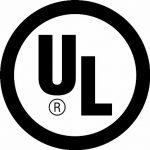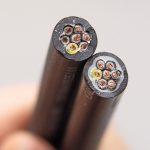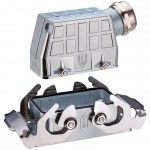More and more of the Lapp Group’s products such as the Ölflex cable series have the designation “UL-certified”, meaning that they are approved for the North American market. This is by no means a given since the standards landscape in North America is rather confusing. Lapp helps its customers to stay in the know.
Certification of cables for North America
Making sense of standards
More and more of the Lapp Group’s products such as the Ölflex cable series have the designation “UL-certified”, meaning that they are approved for the North American market. This is by no means a given since the standards landscape in North America is rather confusing. Lapp helps its customers to stay in the know.
They are an everyday consideration in the vast majority of industry sectors: standards and regulations that determine certain features of a product and certifications that a product must have in order to be used for its intended purpose. People who find German or European standards and certifications complicated have probably never had to deal with their counterparts in North America or in the USA in particular. Requirements are often regulated in more detail and they also differ from one state to another. Nevertheless, more and more Lapp products – such as the Ölflex series – meanwhile fulfil North American standards. European machine builders who want to sell their equipment in the USA or Canada also benefit from this. U.I. Lapp GmbH operates a cableworks in Florham Park (New Jersey) as well as a development centre that is specifically concerned with such issues and provides advice on them to customers.
UL – the measure of all things
When it comes to standardisation in the USA, the initials UL appear time and time again. The Underwriters Laboratory in Northbrook (Illinois) is the undisputed benchmark. Founded in 1894, this independent organisation has a dual function: it defines standards as well as testing them. This gives UL more power than the European institutions, where these functions are kept separately. The relevant technical standards for the cabling of industrial machinery in the USA are the 2012 and 2015 editions of NFPA 79 (National Fire Protection Association). These closely interact with the National Electric Code (NEC), the most impor-tant set of rules for machine and plant construction firms seeking to export their products and solutions. The NEC, also known as the NFPA 70 basic standard, references NFPA 79 in Article 670 (Industrial Machinery). This interaction is based on the fact that the NEC stand-ard includes a section on “General electrical installation” and is thus the basis for every application. NFPA 79 differentiates between several UL certification variants:
- UL listing: Similar to design standards, the features of a variety of cable types are described in UL listings and detailed according to their nominal voltage, materials, wall thickness, temperature range, flammability properties, uses, etc. Applicants can pick the type from the list that best suits the cable to be certified. Among the well-known listing types are TC-ER (Tray Cable Exposed Run), MTW (Machine Tool Wiring) and Flexible Motor Supply.
- UL AVM (Appliance Wiring Material): This refers to tested components, whereby only the minimum requirements are tested. UL-AWM is more flexible to use, which is why most Lapp components are certified in accordance with AWM, for instance numerous cables and all EPIC rectangular connectors. One disadvantage of UL AVM is that, strictly speaking, such components may only be installed in a machine at the manufacturer’s factory, although exceptions are sometimes made here. If a machine is to be set up from scratch at the final site, predominantly UL-listed components are suitable.
- If all this already sounds too complicated, you certainly won’t be glad to hear that the USA has further surprises in store in connection with product approvals. Since the country has a federal structure, the authority for these lies with the individual states. NFPA 79 is a national law which can be supplemented in different ways in different states. For example, in San Francisco there are even stricter fire protection requirements due to the fire which followed the devastating earthquake of 1906. This is the reason why cables with PVC nylon insulation are still widespread in North America. Although nylon improves fire protection, it makes the cable stiffer and is less commonly used in Europe. Nowadays, there are also cables such as the Ölflex Tray VTC, which conforms to the TC-ER listing even without nylon insulation and is therefore more flexible and thinner.
Individual state regulations
Cables developed and produced for the European market, therefore, cannot be used without further ado in the North American market. The reverse is usually possible: in principle, US companies simply have to place the CE marking on their products. No changes are neces-sary to the design. On the one hand, the US NFPA 79 standard is often more narrowly defined, for example with respect to fire protection, so that UL-certified cables generally cover European standards. On the other hand, European standards specify less detailed provisions than their UL counterparts, meaning that they are easier to fulfil even though the European standard is no less demanding technically. This is a clever move by the USA that erects barriers for foreign companies and protects local manufacturers.
No unnecessary costs
This is not an insurmountable obstacle, however. Anyone who has familiarised themselves with the idiosyncrasies of North American standards and certifications can easily find a way to make their products suitable for this market. A bigger challenge for European companies seeking to export to the USA is that they have to use different, more expensive components there than within the EU. The corresponding components are generally cheaper in the USA, so that these regulations don’t just protect domestic component manufacturers but also machine manufacturers.
The sheath material used for a cable is a good example here. Polyvinyl chloride, or PVC for short, is the standard. It has good properties and is suitable for many uses. There are numerous PVC variants when it comes to cable insulation, for instance with additives for better fire protection. The PVC prescribed by UL must exhibit a high level of fire protection and is therefore more expensive. Simple and cheap PVC is completely sufficient for all other markets and is in no way inferior. Customers only pay for what they really need. Lapp takes a pragmatic approach: the customer receives a cable that fulfils their requirements – UL-certified for North America and IEC-certified for all other markets.
One cable for every market
In some cases this distinction is irrelevant nowadays. This is why Lapp offers the Ölflex Servo FD 796 CP, for example, as a shielded servo cable with a PUR sheath for high-speed applications. It fulfils both the IEC standard and the American UL 20234 as well as the Canadian CSA (Canadian Standards Association). Since insular solutions are increasingly a hindrance in the global economy, Lapp often chooses alternatives that are suitable worldwide from the outset when developing new solutions.
Will there be fewer hurdles when the TTIP free trade agreement comes into force? This is not at all certain since fundamental differences remain, such as the units of measurement for cable diameters. These are classified in the USA using the AWG (American Wire Gauge) scale whereas the metric system, i. e. square millimetres, is the norm in Europe and the rest of the world. A cable with a cross-section of 1.5 mm2 corresponds to AWG 16. Unfortunately, simple conversions are not possible. The role played in North America by national pride should not be underestimated. There have been cases where a Canadian inspector would not connect a US manufacturer’s machine to the mains because it did not have the Canadian CSA certification – even though there has been a comparable free trade agreement between the USA and Canada for a long while.
Lapp’s experts are always ready to offer guidance and advice in finding the right solution, even for the trickiest of certification issues.
www.cpp-net.com search: cpp0316lapp
Lucas Kehl
Lucas Kehl
Product Manager, Lapp Group, New Jersey
Share:









